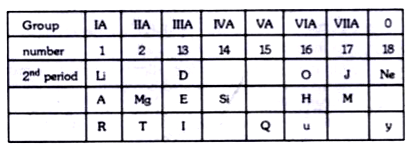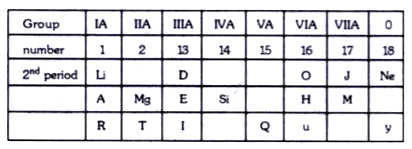Use the periodic table to answer the following questions :
Identify an element that would tend to gain two electrons.
To identify an element that tends to gain two electrons, we can follow these steps:
Step 1: Understand Electron Affinity
Elements that tend to gain electrons are usually nonmetals. They have high electronegativity and a strong tendency to achieve a stable electron configuration, often resembling that of the nearest noble gas.
Hint: Look for nonmetals in the periodic table, especially those in groups that typically gain electrons.
Step 2: Locate Nonmetals on the Periodic Table
On the periodic table, nonmetals are found on the right side. Groups 15, 16, and 17 contain elements that tend to gain electrons.
Hint: Focus on groups 16 and 17, as these groups are more likely to gain electrons.
Step 3: Identify Group 16 Elements
In Group 16, we have elements like oxygen (O), sulfur (S), and selenium (Se). These elements typically gain two electrons to achieve a stable octet.
Hint: Consider the common oxidation states of elements in this group.
Step 4: Confirm Oxygen's Electron Gain
Oxygen (O) is a well-known example of an element that gains two electrons. When it gains two electrons, it forms the oxide ion (O²⁻), achieving a noble gas configuration similar to neon (Ne).
Hint: Check the electron configuration of oxygen to see how it achieves stability.
Step 5: Conclusion
Thus, the element that tends to gain two electrons is Oxygen (O).
Final Answer: Oxygen (O) tends to gain two electrons.
---
Elements that tend to gain electrons are usually nonmetals. They have high electronegativity and a strong tendency to achieve a stable electron configuration, often resembling that of the nearest noble gas.
On the periodic table, nonmetals are found on the right side. Groups 15, 16, and 17 contain elements that tend to gain electrons.
In Group 16, we have elements like oxygen (O), sulfur (S), and selenium (Se). These elements typically gain two electrons to achieve a stable octet.
Oxygen (O) is a well-known example of an element that gains two electrons. When it gains two electrons, it forms the oxide ion (O²⁻), achieving a noble gas configuration similar to neon (Ne).
Thus, the element that tends to gain two electrons is Oxygen (O).
Topper's Solved these Questions
- CLASSIFICATION OF ELEMENTS AND PERIODICITY IN PROPERTIESBOOK - ICSECHAPTER - CLASSIFICATION OF ELEMENTS AND PERIODICITY IN PROPERTIESEXERCISE - ASSERTION-REASON TPE QUESTIONS
6 Videos
- CHEMICAL THERMODYNAMICS BOOK - ICSECHAPTER - CHEMICAL THERMODYNAMICS EXERCISE - NCERT TEXT-BOOK. EXERCISES
22 Videos
- ENVIRONMENTAL CHEMISTRY BOOK - ICSECHAPTER - ENVIRONMENTAL CHEMISTRY EXERCISE - NCERT TEXT-BOOK EXERCISE
20 Videos
Similar Questions
Use the periodic table to answer the following questions :
Identify an element that would tend to lose two electrons.
View SolutionUse the periodic table to answer the following questions :
Identify an element with five electrons in the outer subshell.
View SolutionUse the periodic table to answer the following questions.
a. Identify an element with five electrons in the outer subshell.
b. Identify an element that would tend to lose two electrons.
c. Identify an element that would tend to gain two electrons.
d. Identify the group having metal, non-metal, liquid as well as gas at the room temperature.
View SolutionUse of Modern periodic table to answer the following questions:
(i) Identify an element with six electrons in the outermost shell.
(ii) Identify an element that would tend to lose one electron.
(ii) Identify an element that would tend to gain three electrons.
(iv) Identify the group having metal, non-metal, liquid as well as gas at 30∘C temperature.
View SolutionUse the periodic table to answer the following questions :
Identify the groups having metal, non-metal, liquid as well as gas at the room temperature.
View SolutionA part of the periodic table is shown below with one element missing :

Based on the above table , answer the following questions :
Name the element that has duplet structure.
View Solution
• In this table H does not represent hydrogen.
• Some elements are given in their own symbol and position in the periodic table.
• While others are shown with a letter.
With reference to the table answer the following questions :
Identify the element from period 3 with least atomic size.
View Solution
• In this table H does not represent hydrogen.
• Some elements are given in their own symbol and position in the periodic table.
• While others are shown with a letter.
With reference to the table answer the following questions :
Identify the noble gas of the fourth period.
View Solution
• In this table H does not represent hydrogen.
• Some elements are given in their own symbol and position in the periodic table.
• While others are shown with a letter.
With reference to the table answer the following questions :
Which element from group 2 would have the least ionization energy?
View SolutionUse the letters only written in the Periodic Table below to answer the question : Which element has its electrons arranged in four shells.

View Solution
